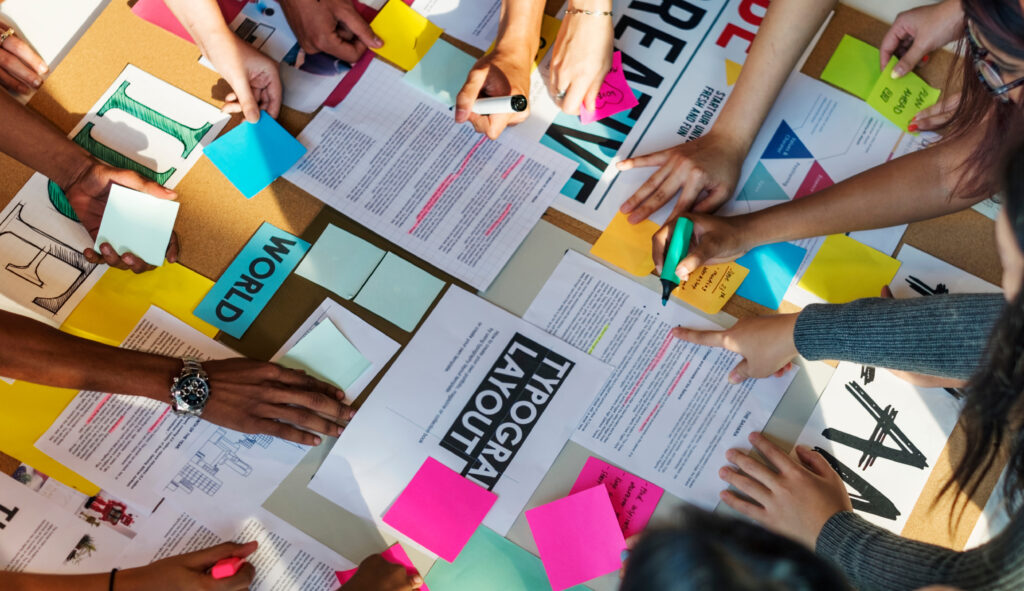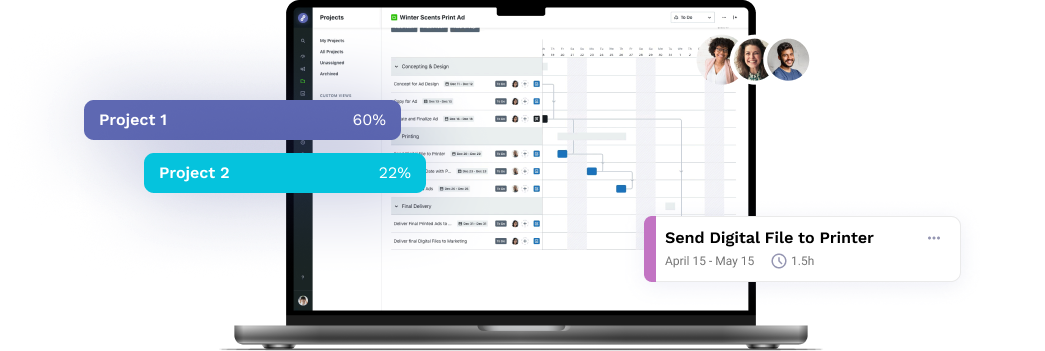
When it comes to effective campaigns and the creative process behind them, both the creative team and their stakeholders play key roles.
Sharing the right information at the right time is key to building a stronger partnership. In-house creative teams face the unique challenge of having clients that are also coworkers. This means they have more ability to keep their teammates informed about their project and the creative process than ever before, but that comes with risk.
Showing stakeholders what goes on “behind the curtain” during the creative process is risky. For linear thinkers, the creative process can look messy, unorganized, even a bit chaotic. Your stakeholders can start to lose confidence in the creative output if they don’t understand the process of getting to the final deliverable.
If transparency in the creative process is mishandled, it can turn into micromanaging and “design by committee”, both things all creatives dread. This concern about “over-sharing” and what may come from that, cause many creative teams to hold their work hostage, waiting until everything is perfect before sharing with stakeholders. However, this other extreme rarely works out either. When you isolate the stakeholder, you take the very real risk of missing the mark on the creative and having to go back to the drawing board late in the game. This can cause all sorts of really big problems like missed deadlines, long nights at the office, exploding budgets, and a damaged relationship with stakeholders.
Walking this fine line between completely blocking your stakeholders from the creative process or losing control over the creative output is a key responsibility for creative leadership. Here are a few tips we have put together based on experiences from our Account Managers and Creative Director to help you navigate this minefield:
Educate Stakeholders on the Creative Process
You have to understand that creatives have a very different “average day” than their stakeholders. Take the time to educate stakeholders about the creative team and the creative process. Whenever I onboard a new client or stakeholder, I take time to walk them step by step through the creative workflow, from request intake to review and approval, and ask them when they would be the most comfortable being looped in.
You learn a lot about your stakeholder this way. Some people can’t visualize an idea, so they need to see a comp early on. Others really only care about the copy and want to have a lot of control during the writing phase. By having this discussion upfront, you can set up touch points that are meaningful to your stakeholder.
Let Stakeholders Know What You Need from Them
This is also the time when I explain how important the creative brief and kick off meetings are to the successful outcome of the project. Your stakeholders are experts in their field, so let them know how important their strategic direction is to the outcome of the project. By explaining how their role supports the entire creative process, you can secure their buy-in.
Share Early and Often
Don’t wait until final layout to share creative work with your stakeholder. On my team, we get approval on copy first before moving to design, which we share for feedback over multiple stages.
The best way to get feedback is through an intuitive online review and approval tool. The easier you make it for your stakeholders, the faster you’ll get their feedback. Help keep the feedback on point by referencing the creative brief. If the feedback you get is contradictory to the goals in the brief, don’t be afraid to let your stakeholders know that. If their goals have changed, make sure to get the brief updated. At the end of the day, your brief should be the roadmap for the entire project.
Share Job Status
In addition to sharing creative output, you should also share the status of their projects. A robust client portal can give your stakeholders access to where their projects are in the process. This helps them make sure they are responding when they are supposed to, so you don’t get held up because of a slow approval process.
Invite Stakeholders to Your Brainstorm Session
Whenever I’ve had stakeholders take part in our brainstorm sessions, the end result has been better. There are several reasons for this. For one, we get to see how their brains work. This helps us communicate later on. Another is they get to see how hard it can be to come up with unique, creative ideas. I’ve had clients say to me after brainstorming sessions things like, “that was exhausting” “I don’t know how you do that all day”. Finally, it helps to build relationships with your stakeholders by getting into a freer environment where everyone is sharing ideas without worrying about titles and putting on a good show for the client.
In Summary
- It takes good communication between your stakeholders and your creative team throughout the lifecycle of the project to achieve a successful end result.
- Educate your stakeholders so they know what to expect
- Involve them in all critical steps of your process, so you don’t have to go back to the drawing board late in the game
- Make it easy for them to provide their feedback and have access to the status of their jobs
- Show them a glimpse of what goes on in the creative process. It will help them work better with you, and the more they are involved, the more they will trust you and have confidence in the team going forward.
Are you interested in tools that will help you address current creative process challenges and provide you with the support needed for future ones? Lytho helps you streamline workflows and harmonize all brand collateral under a single, uniform platform. Feel free to reach out to us by scheduling a demo and learning how our creative solutions can boost the effectiveness of your creative projects. We look forward to speaking with you!
Do you want to give yourself and your creative team more room for creative stimulation by automating the boring stuff? Lytho helps you streamline your entire workflow and harmonize all brand collateral under a single, uniform platform. Feel free to reach out to us by scheduling a demo and learning how our creative solutions can boost the effectiveness of your creative projects. We look forward to speaking with you!

Ready to simplify your creative operations and start having a little fun at work again? Schedule time to talk with us.
Let us show you how Lytho’s Creative Operations Platform helps in-house creative and marketing teams do better work, ease the stakeholder experience, and stay on brand.
Schedule a Demo